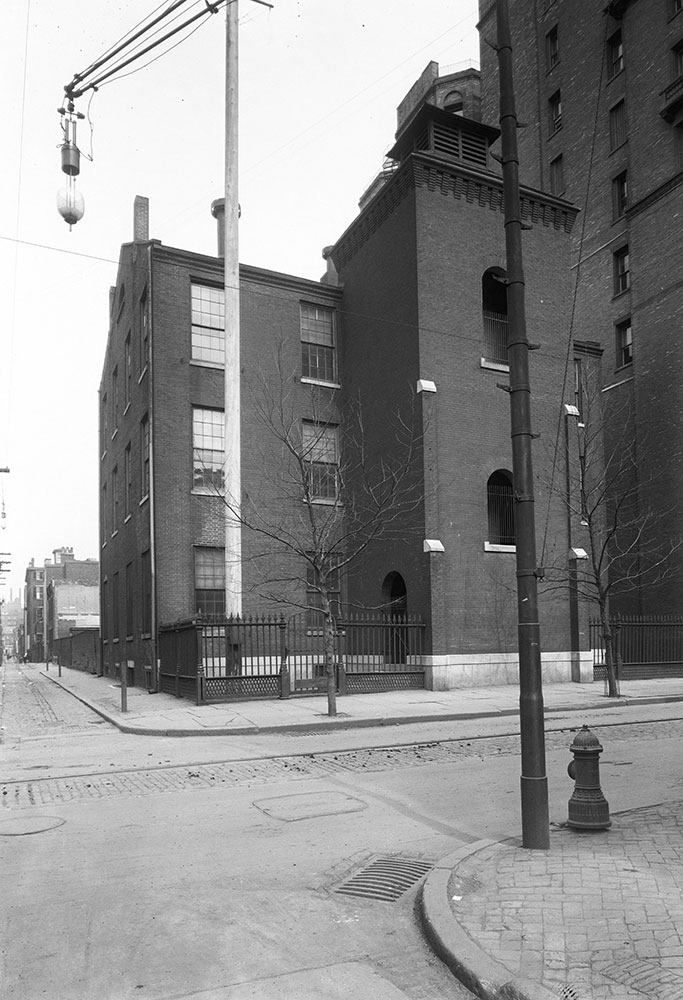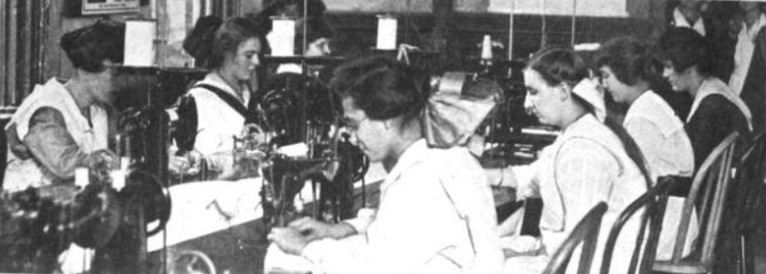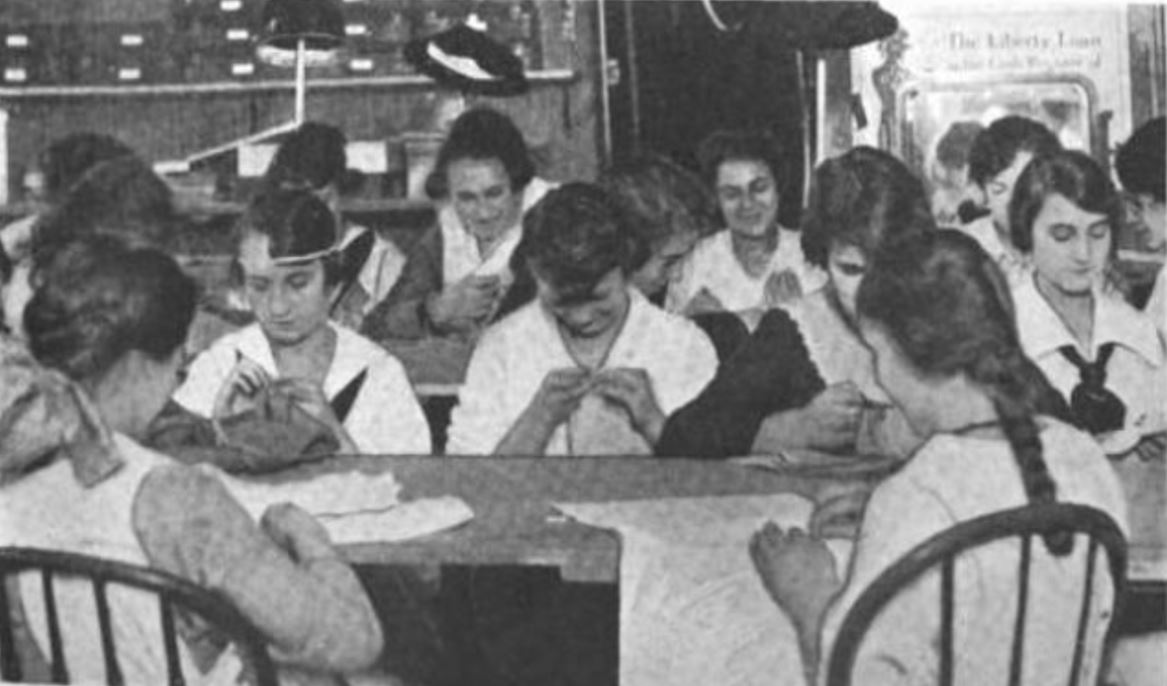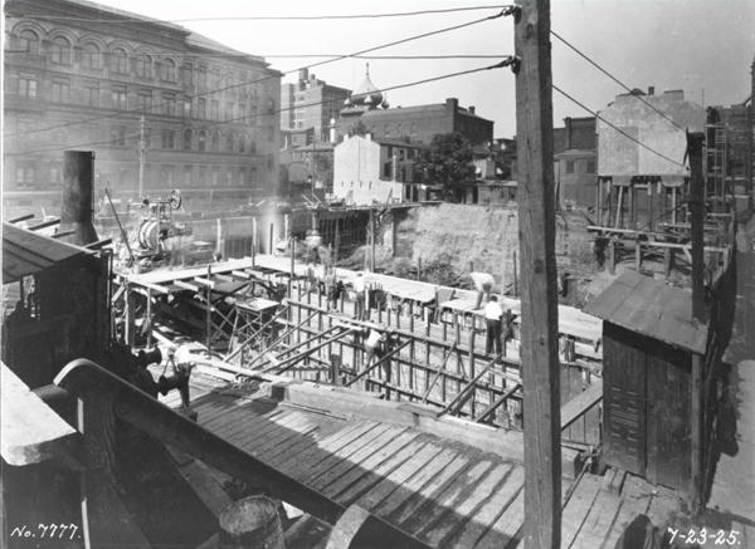
Rebuilding rendered the brick building at Pine and Quince Streets barely recognizable. But the three-story structure, once known as the J. Sylvester Ramsey School carries with it a web of worthy associations.
Those of a certain age will remember the building as Phineas Meade’s antiquarian den, an overcrowded haven for all things old, dusty and wooden. Phin, as he was known, occupied the building from 1949 until his death in 1983.
Those interested in the history of architecture would lean into the significance of the original structure built in 1850.
Students of the Seventh Ward would recall W.E.B. DuBois’ observation that the school was the largest in the ward with a “nearly all colored” student body of nearly 500.
And then there’s the story of Philadelphia’s Trade School For Girls, which occupied the building starting in 1918.
That year, something like eleven million women and girls were in the American workforce. Philadelphia’s bourgeoning industries employed about 94,000 girls between the ages of 14 and 16. Of them, 27,000 worked in the garment trades, a number that increased year to year. Four thousand of these wage-earning girls were also enrolled in the city’s schools.
And yet the city’s public schools offered little or no training relevant to their employment.
“The majority of these women were not fitted for any type of work,” declared Cleo Murtland, an authority on industrial education. Their education is “seriously lacking.”
But things were about to change. A group of philanthropic reformers (all women) had taken over a rowhouse at 415 South Ninth Street (the building still stands) and established there a school that provided free instruction in “dress making, millinery, lampshade making and novelty work,” skills that would “enable the untrained girls of the city to earn a livelihood in the industrial world.”
With only 79 students, this first iteration of Philadelphia’s Trade School for Girls only scratched the surface. Then Philadelphia’s Committee on Vocational Education recruited Murtland from the Manhattan Trade School for Girls, an “experiment without precedent” (memorialized here in a short film from 1911). Murtland hit the ground running, in Philadelphia, surveying “upwards of 600 factories, where women and children are employed” and then designing an expanded vocational curriculum to be funded and operated by the School District. During its first year, according to Murtland, “educators, employers, workers, public spirited citizens, educational, civic and philanthropic organizations … [all] urged the public school authorities to recognize its place in the public school system of the city.”
They succeeded in getting their message across. And with funding from the city and Murtland as principal, the school took over the school building at Pine and Quince Streets.
Murtland later wrote: “Philadelphia is one of the largest industrial cities in the country, a city of varied industrial activities, the center of the knitting industry, a leading city in the manufacture of cotton and woolen woven fabrics, a shoe manufacturing center, a community with large printing establishments, extensive jewelry factories, and many other industrial interests which employ women workers.” The city “presents an extensive and varied field for the development of vocational education…”

Vol. 7 – (Milwaukee: The Bruce Publishing Company , 1918)
“Philadelphia is in a position,” wrote Murtland, “to develop an industrial education program second to none in the country.”
Courses included “custom dressmaking, children’s custom-made clothing, custom millinery, factory garment making-dresses and waists, muslin underwear, shirts and special machine work such as machine hemstitching, buttonholes, machine embroidery, two needle stitching, and bonnaz embroidery…” In a school week of 32 hours, more than half of the time was “devoted to trade work.” “The course of study” included “power-machine operating, dressmaking and millinery, with such related subjects as business methods and English.” Special attention was given “to civics and good citizenship.”

Vol. 7 – (Milwaukee: The Bruce Publishing Company , 1918)
In 1919, Murtland left her position at Pine and Quince for an associate professorship at the University of Michigan where she tackled similar challenges and opportunities in Detroit.
Back in Philadelphia, the case for vocational education for girls and young women had been made. And in December 1925, the Inquirer reported the laying of a cornerstone for a new, five-story trade school for girls and women. When operational, the Helen Fleisher Vocational School at 13th and Green Streets would accommodate 1,200 girls and women.

In theory, vocational education would position young women to earn higher wages. In reality, according to the 1922 Report of the Survey of the Public Schools of Philadelphia, there was no minimum wage law in Pennsylvania. Girls and women comprised a fifth of the workforce but earned only a tenth of the total wages. In factories and mills that produced clothing, two thirds of the workers were female. They earned only a third of the total wage.
In industrial early 20th-century Philadelphia, the glass ceiling was fabric rather than glass. And it was stitched tightly, one might say irrevocably, in place.
[Sources: Franklin Davenport Edmunds, The Public School Buildings of the City of Philadelphia from 1845 to 1852. (1915); Cleo Murtland, “Pennsylvania’s First Trade School for Girls,” The Industrial Arts Magazine, Vol. 7 (Milwaukee: The Bruce Publishing Company, 1918); Report of the Survey of the Public Schools of Philadelphia, Volume 3 (Public Education and Child Labor Association of Pennsylvania, 1922). The Philadelphia Inquirer: “Consumer’s League Official Resigns – Philadelphia to Have Girls Trade School,” May 27, 1914; “To Aid Untrained Girls,” October 1, 1916; “Education Board Takes Trade School for Girls,” January 3, 1918; “A Trade School for Girls,” January 6, 1918; “To Teach Trades to Girls,” September 8, 1918; “School to Broaden Training for Girls in Philadelphia Industry,” November 21, 1920; “The Board of Education Programme,” January 15, 1925; “Cornerstone Laid For Trade School,” December 16, 1925.]



6 replies on ““Philadelphia’s First Trade School for Girls””
So exciting to have some new information about an old school. I am doing a session and a full for adults about Philadelphia and one is about school so now I have something different. Thank you.
It is for adult education here in Wilmington DE all about institutions in Phila, with one session about public schools. I don’t know how the first “commentary” came through so poorly.
Very cool. News to me. I was aware of the Helen Fleisher school for the needle trades (btw, no “c” in Fleisher – she came to her interest in textiles via her family’s ownership of the Fleisher Woolen Mills Grays Ferry. Helen Fleisher and the young women who attended the school at 13th and Green were also honored by Meg Saligman’s majestic mural – visible for a while longer from Broad and Spring Garden…
Thanks, Thora. And thanks for the additional context and the editorial help.
The building at Pine and Quince that’s there today is a new building. The 1850 school building was assassinated by a rapacious developer with an assist by the Philadelphia Historical Commission that accepted a bogus structural engineering report. An old and common tale in Phila. The developer promised to “recreate” the form of the original building. Alas.
Bill,
Thanks for the correction. I had wrongly assumed that the old building was somehow cocooned in the new one. What a travesty that the original is gone.